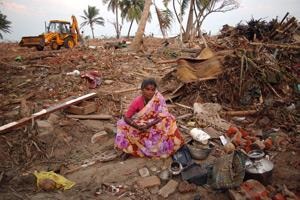Increased forest threat from extreme weather
9 August 2011, Rome - Extreme weather events and natural disasters will pose an increasing threat to the world's forests in coming years, requiring heightened cooperation between regions and countries, an international partnership for forest conservation and improvement warned today.
The Collaborative Partnership on Forests (CPF), comprising 14 international organizations and secretariats, issued its warning as FAO released a new report, Abiotic disturbances and their influence on forest health.
Almost 4 000 extreme events — so-called ‘abiotic disturbances' such as cyclones, floods, landslides, tornadoes, earthquakes, volcanic eruptions and "mega" forest fires — occurred between 2000 and 2009 worldwide, according to the report. And recently they have also included man-made events such as radioactive contamination and oil spills.
The CPF called upon forest managers to apply forest policies such as diversifying species, using windbreaks and mixed cropping patterns to protect forests from disasters, minimizing the risks and impacts of extreme events.
"Disturbances are expected to continue to increase in intensity, quantity and frequency," said Eduardo Rojas-Briales, FAO's Assistant Director-General for Forestry and CPF Chair. "Adaptive forest management involving all sectors and stakeholders is therefore essential to protect the world's forest resources. And since such disturbances do not respect borders, regional or international cooperation is badly required."
Examples of abiotic disturbances and their impacts on forests include: a major storm in Sweden in 2005, which uprooted or damaged trees in over 1.2 million hectares of forest; Tropical Cyclone Sidr, which hit Bangladesh in 2007 and affected almost nine million people and damaged nearly 1.5 million houses and some four million trees; and the 2010 earthquake and subsequent tsunami in central Chile, which killed more than 700 people and caused up to $30 billion in economic losses to the country.
Minimizing damage from extreme events
The condition of forests themselves can have an influence on the extreme events. For example, deforestation or poor management can increase flooding and landslides during cyclones. Degradation of mangrove forests may increase the damage caused by storms or tsunamis.
Observations from the Maldives showed that coastal forests are most resilient to tsunami impacts when left as an undisturbed, mixed-species community. Sand dunes, mangrove forests and coral reefs all help to reduce the energy of tsunami waves as well as retain soil and preserve safe conditions to allow biodiversity to thrive. Although mature mangroves are quite resistant to water surges, there are limits to this resilience.
In 2004, when the Indian Ocean Tsunami hit Indonesia, it cleared nearly 49 000 hectares of coastal forests (excluding mangroves) and significantly damaged nearly 300-750 hectares of mangrove forests, representing economic losses of $21.9 million and $2.5 million, respectively. But with improved coastal and mangrove forests management these types of effects can be substantially reduced.
According to Emmanuel Ze Meka, Executive Director of the International Tropical Timber Organization (ITTO), "ITTO-funded projects to rehabilitate tsunami-damaged mangroves in the Ayeyarwady delta of Myanmar, in Phang Nga and Ranong Provinces, southern Thailand, and in many other countries are helping to ensure that future extreme weather or tsunami events will be less damaging to local communities than the tragic 2004 Indian Ocean event."
Climate change impacts can heighten intensity of events
Expected increases in the frequency, severity of drought and heat stress associated with climate change can fundamentally alter the composition and structure of forests. Increases in tree mortality are of particular concern because decaying trees also release large amounts of carbon into the atmosphere.
Moreover, decreased rainfall and more severe droughts, such as that presently being experienced in the Horn of Africa, are expected to be particularly stressful for African populations that depend on forests for food, clean water and other basic needs.
"Climate-change adaptation planning is hampered by a lack of information about current and future climate-related impacts", said Steve Makungwa from the Forestry Research Network for Sub-Saharan Africa (FORNESSA), an initiative that has worked with the International Union of Forest Research Organizations (IUFRO) on climate change impacts on African forests. "There is a need for reliable regional projections as well as early warning systems that require investments in research and monitoring infrastructure."
In November 2011, the Intergovernmental Panel on Climate Change (IPCC) will release a Special Report on managing the risks of extreme events and disasters to advance climate change adaptation. The report aims to become a resource for decision-makers to more effectively manage the risks of these events.
In advance of the report, CPF partners also called upon forest managers to develop strategies to adapt to future drought events reducing tree density to ease competition, selecting plants with improved drought resistance, and shifting from monoculture plantations to species-rich forests.
